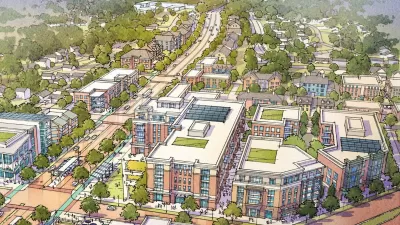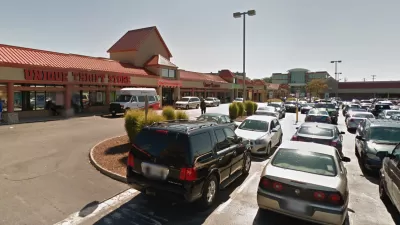The D.C. suburbs seem to be fertile ground for some of the nation's most ambitious retrofit projects. The latest plan to be made public would transform a 1950's era apartment and retail complex in Silver Spring, reports Jonathan O'Connell.
With the region emerging from the recession as perhaps the strongest economy in the nation, and recent trends in population growth projected to continue, developers and planners are bullish on the potential to transform Washington D.C.'s inner suburbs into urbane mixed-used transit-oriented communities. We've heard recently about plans afoot for Tysons Corner in northern Virginia. Now comes news about plans by developer Tower Cos. to overhaul the Blairs apartment and retail complex in Silver Spring, Maryland.
"Silver Spring, like many of Washington’s suburbs, is quickly evolving to accommodate an influx of residents and shoppers seeking neighborhoods that are walkable and accessible to public transit," writes O'Connell. "The Blairs’ massive surface parking lot and steep slope make the area difficult to navigate on foot. For a property near the Silver Spring Metro and MARC stations, as well as a revitalized downtown area, Tower officials believed that it was time for a major change."
“The Blairs has had a suburban design, and it has been that way since the 1960s,” said Ed Murn, Tower’s director of development, adding that “what we’re trying to do is transition to an urban, transit-oriented, pedestrian-friendly community.”
"Over the next 10 years, Blair Towers would be replaced by four much larger high-rise apartment buildings, ranging from 260 to 370 units each," explains O'Connell. "Tower hired Canadian architect Bing Thom, who designed the renovated Arena Stage in Southwest Washington, and Massachusetts planning and design firm Sasaki Associates."
"In all, the Blairs would go from having 1,371 apartments to 2,800. 'This is a suburb that’s becoming a city,' Thom said."
FULL STORY: Blairs complex in Silver Spring headed for major overhaul

Planetizen Federal Action Tracker
A weekly monitor of how Trump’s orders and actions are impacting planners and planning in America.

Maui's Vacation Rental Debate Turns Ugly
Verbal attacks, misinformation campaigns and fistfights plague a high-stakes debate to convert thousands of vacation rentals into long-term housing.

Restaurant Patios Were a Pandemic Win — Why Were They so Hard to Keep?
Social distancing requirements and changes in travel patterns prompted cities to pilot new uses for street and sidewalk space. Then it got complicated.

In California Battle of Housing vs. Environment, Housing Just Won
A new state law significantly limits the power of CEQA, an environmental review law that served as a powerful tool for blocking new development.

Boulder Eliminates Parking Minimums Citywide
Officials estimate the cost of building a single underground parking space at up to $100,000.

Orange County, Florida Adopts Largest US “Sprawl Repair” Code
The ‘Orange Code’ seeks to rectify decades of sprawl-inducing, car-oriented development.
Urban Design for Planners 1: Software Tools
This six-course series explores essential urban design concepts using open source software and equips planners with the tools they need to participate fully in the urban design process.
Planning for Universal Design
Learn the tools for implementing Universal Design in planning regulations.
Heyer Gruel & Associates PA
JM Goldson LLC
Custer County Colorado
City of Camden Redevelopment Agency
City of Astoria
Transportation Research & Education Center (TREC) at Portland State University
Jefferson Parish Government
Camden Redevelopment Agency
City of Claremont





























